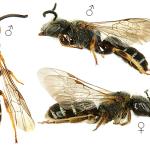Halictus interruptus LEPELETIER 1841 (nec. PANZER 1798)
There are only a few ancient records of this bee from Britain, all from southern England. These are based on single specimens from Kent (Dover and Upper Halling) and East Sussex (Hastings), with unconfirmed, published records, from the Isle of Wight (Sandown (Unwin 1857)), Hampshire (Blackwater) and Surrey (Weybridge) (Smith 1876). However, R.C.L. Perkins encountered two thriving nesting aggregations at Chudleigh, South Devon (Perkins 1919b), which persisted from 1919 to 1930. The continental range extends from Finland to Iberia, east to Transcaspia. In the southern part of the range it is apparently confined to higher situations (Ebmer 1988). It is a common species in much of western Europe.
There seems to have been two sites at Chudleigh: the bank of an old gravel pit by the River Teign opposite Chudleigh Knighton, and a pasture field down the river valley at Gooseham (Perkins 1919b and G M Spooner, pers. comm.).
Females fly from May to September, males from early July to September.
At least one of the Chudleigh populations nested in a loose aggregation (Perkins 1919b). The very characteristic burrow entrances were described by him as being scattered over three or four square metres. The diameter of each burrow appeared small for the size of the bee and the excavated spoil lay around the entrance, not heaped above it. On digging out a specimen it was found that the upper section of the main burrow was constricted and it was in this part that the female guarded her nest, her head exactly filling the entrance. So tight was the opening that a pollen-laden female returning to her nest deposited a ring of pollen around the burrow mouth, this being accidentally scraped off her hind legs as she entered. The female's large head and narrow, cylindrical body are presumably adaptations for such a nesting habit. This is a eusocial species, with a worker caste. The nest architecture and habits are described by Wu (1960), Westrich (1989) and Pesenko, Banaszak, Radchenko & Cierzniak (2000).
Smooth hawk's-beard (Crepis capillaris) is the only British record (Saunders 1879).
None reported from Britain.
Proofed: January 2012


